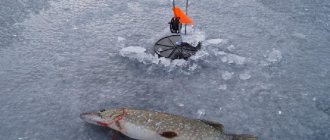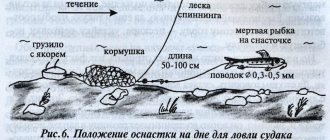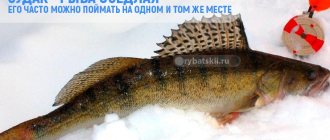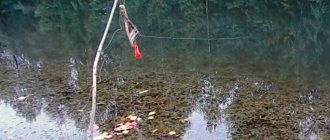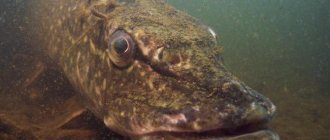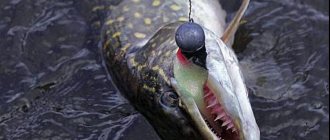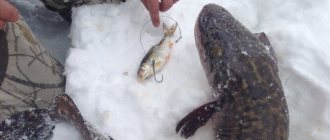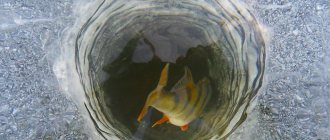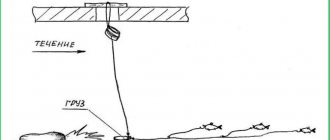And then putting the live bait on the hook and lowering the rig into the water, fixing the flag and so on with each bait. And then the waiting process begins. At this time, you can catch live bait with a regular winter fishing rod or any other fish.
If you delve into the question of the options for girders that are used by our fishermen for catching pike and other predators, you can find a bunch of options for such girders of the most varied shapes.
But there is one most common option, using an example of which we will show you the structure of most variants of the vents.
The figure shows and labels the main elements of the vents. The rest of the many girders differ from the one presented above only in the version of the stand. Namely, there are girders on a tripod, girders that simply stick into the snow, next to a hole, an American version of girders, and many other narrowly widespread variants.
I think the principle of operation of the girders is clear to you and you don’t need to explain it.
And any girder is suitable for pike fishing, even the simplest one. Usually in stores the price for such girders ranges from 70 to 100 rubles, but of course there are more expensive options, but I don’t see the point in buying them.
How can you make the work of the rig while fishing as convenient as possible?
Good afternoon everyone!
Despite the fact that many people think that fishing with girders is simple and unsophisticated, it is only formally so, there are many nuances, features and tricks that can significantly increase the bites of a predator, making them as effective and confident as possible, especially on the last ice.
In other words, to see bites where other pike are bored, and get confident unwinding when others only get idle tans.
How to successfully fish in the dark?
There is no question now of leaving the traps for the night and going to bed, and upon arrival getting a sleeping predator sitting on the tackle.
Practice shows that it is at dusk that the largest pike feed, not to mention pike perch and burbot, which are practically impossible to catch during the day; it would be a sin not to take advantage of the situation.
Most often, the task is to lose full control over the fishing rods; seeing the flag in the dark and observing all stages of the bite is not easy, and therefore you need to modify your gear.
A strip of reflective fabric is hung on the flag, you can sacrifice an old flicker, which is visible in the light of a headlamp at a distance of several hundred meters, the reel is painted with special reflective paint, watching it unwind in pitch darkness is an indescribable spectacle.
How can you make the work of the rig while fishing as convenient as possible?
We are, of course, talking about fishing line, in an effort to ensure maximum reliability, fishermen often coarsen it unnecessarily, wind fishing line with a diameter of 0.4, 0.5, or even 0.6 mm onto the reel, this is not a solution, thick fishing line quickly cakes on the reel, which is why it comes off it. rings, overlaps the rack, the fish feels resistance, the ending is known.
The solution in this situation is a thin line of the order of 0.3 - 0.35, its thickness is enough to ensure the correct operation of the tackle and at the same time the necessary strength to cope even with a large trophy, but there is no need to use a thinner line, cuts to the phalanges of the fingers are a very painful thing.
How to launch live bait to the required horizon?
This problem that everyone has to solve, the lack of oxygen at the bottom, algae, or other features, force the fisherman to sometimes raise the girder above the bottom, however, guessing the horizon that is promising for fishing is not very easy, the easiest way is to give the opportunity to choose the bait fish itself, and this can be done with two ways.
1. Equip the bait with a light weight of about 2-3 grams, a sinker that will not have much influence on the live bait and will not pull it to the bottom.
2. Fix a small silicone stopper between the sinker and the leash assembly; by lifting it, the angler has the opportunity to change the location of the sinker in the water column by fixing it at the bottom, in the floor of the water, or under the ice, thus giving complete freedom of action.
How to avoid annoying derailments due to faulty gear?
Most often we are talking about a carbine that attaches the hook to the wiring; practice shows that it is this unit that is the first to fail during fishing, ensuring the predator’s escape.
That is why the first task of the fisherman is to get rid of all these elements, the simpler the more reliable, and to fix the hook to the tackle it is better to use a small winding ring, the same goes for the swivel, it is better to replace the small swivel with a more powerful and durable one, or fix the leash on the main fishing line using the loop-to-loop method.
Which leash should you choose?
Anglers who complain about the complete lack of bites most often equip their fishing rods with thick metal leashes from under the sky, if necessary, they can pull the car out, but meanwhile the leash is a unit that is directly responsible for the number of bites, practice shows that the top 3 leashes for pike look like this .
1. Fluorocarbon, it is fluoro that shows its best side during passive biting, it is best to choose a thick one, about 0.6 mm in diameter, the pike will hardly be able to cut it, and the number of bites can differ significantly.
2. Thin leader material, 8 or 16 strands, is not bad for passive biting, and in terms of catchability, it retains priority with flurry. I lost to him in particularly difficult conditions.
3. Metal, which is not a bad material and has successfully proven itself when fishing with girders, under similar conditions showed itself to be worse than fluorocarbon, but is located somewhere next to the leader material.
Which hook to choose for pike?
If we are talking about active fishing for girders, a classic tee with a wide hook and a compact fore-end is best suited; a forged one is not used, but in a number of situations a double or single hook is used.
Well friends, that’s all, take care of yourselves!
- The live bait falls into the hole.
- The fishing line of the required length is unwound.
- The spool with fishing line is fixed by bending the flag and resting on the spool of the reel.
- When the bite occurs, the pike will try to drag the bait away.
- The line will begin to unwind from the reel.
- The signaling part of the rod will be released and rise up, eventually starting to signal the angler about a bite.
Features of fishing with girders
Winter fishing can be quite varied. It differs primarily in the climatic conditions of the period when the fisherman decided to go out to the reservoir. That is why it is extremely important for both beginners and professionals to understand what the main nuances of pike fishing are in early December, January, February or early March.
On the first ice
After the icing of the reservoir appears for about two weeks, the pike does not change its lifestyle. She does not swim away from her typical habitat, continuing to hunt in them for a certain time. This is due to the presence of a relatively significant number of fry in this area. Most often this concerns edges - places where there are significant differences in depth.
Catching pike on ice rigs on the first ice can be quite effective, but being on a body of water requires extreme caution.
In the wilderness
In the dead of winter, the danger of falling through the ice is usually minimal. That is why the precautionary rules during this period of time are less strict than when the first ice appears.
The main feature of pike fishing in the dead of winter is that the predatory fish at this time goes hunting for only 20 or 30 minutes. If you miss this period, the catch may be minimal. Often after fishing you can return home with nothing.
In order to catch a pike in winter in severe frost, you need to try hard. At the same time, you should have self-control, correctly following all the rules regarding such fishing.
On the last ice
The main feature of catching pike on girders in early spring is the need to follow certain safety rules. This is due to the fact that during this period of time the ice is significantly thinning. That is why experts recommend that fishermen adhere to the following rules:
- Under no circumstances should you go to the pond alone.
- You should always take an ice pick with you.
- In addition to all other devices, it is advisable to have a rope in your inventory.
In early spring there is a high chance of catching trophy pike. As a rule, by this time they gain weight both in lakes and rivers. To catch fish on the last ice, it is best to use small roach or rudd as live bait. In the first days of March, predators are of little interest in perch or ruff.
Fishing during this short period of time is a real pleasure! During the day, the sun warms and gives the first tan, and at night light frosts barely grasp the holes with a thin mica crust. Since ice quickly loses thickness, becomes loose and pliable, drilling it is not at all difficult. You can spend the whole day fishing without problems and with pleasure
Choosing live bait
Without live bait, it will not be possible to achieve success in fishing with girders; for this, they select a medium-sized fish, preferably caught in the same body of water. Excellent options include crucian carp, roach, ruffe and even small perch.
They are most often attached through the gill covers or behind the dorsal fin, which will allow them to remain active longer.
We have figured out where to catch pike in January and other months on the girders, the main thing is to select high-quality ingredients and active live bait, then fishing will definitely go off with a bang in any of the periods of freeze-up. It is worth paying special attention to the weather; during thaws and cloudy skies, fishing will be better than in frost and sun.
Bait for pike
True, when using small live baits, for example, bleaks and roaches, you can encounter a serious problem. These are attacks by perches that crush and wear down the baitfish, making it completely unattractive to pike. At the same time, the striped robbers themselves are very rarely hooked (photo 9)
. Interestingly, at the end of winter, perch appear in the shallows at the same time as pike. Maybe they are hoping to profit from her caviar?
Vitaly Volkov, b.p. Svetly Yar, Volgograd region
Pike fishing on the last ice
The most important of them:
The process of fishing with girders
Fishing for pike on girders near the shore in winter
During glaciation, pike experience less anxiety compared to peaceful fish. The first couple of weeks after the ice begins to form, it does not change its classic sites and hunts at the bottom, where a large number of fry are found. At this time, pike are caught in the edges with the most sharp changes in height of the bottom of the reservoir.
The main thing in catching pike in winter using girders is to adhere to the following rules:
- Make sure that the coil does not have any play in the axis. When putting it on the pin, be sure to use a sleeve; it is best that it be made of fluoroplastic, which is poorly susceptible to freezing to the iron base if moisture suddenly gets between them.
- The bite alarm should be activated when a force of 0.1-0.15 kilograms is applied, and no more.
- The reel, when unwinding, must have braking inertia to avoid unnecessary unwinding of the line.
Fishing for pike on girders on the last ice
The most important thing is to remember safety precautions when fishing on spring ice.
The most important of them:
- Fish with a partner
- Don't fish without an ice pick
- Take a rope with you.
On the last spring ice you can easily catch trophy prey. Small baits are used by almost all girders, but real trophy fish await the fisherman with girders.
Fishing for pike using jigging rods on the edges
This fishing is a little more difficult, but on the edges there is a great opportunity to catch predatory fish. Most fishermen do not go into all the details and fish incorrectly. The dump needs to be surrounded by a “chessboard” of 9-16 meters and that’s it. But it is worth remembering that pike is found in shallow waters, and pike perch is found in deep water.
When playing, you should not force events. After being brought to the hole, the caught pike is removed onto the ice using a fishing line or holding it by the leash. It is better to catch large fish, weighing more than 2 kg, under the gills from the back. If you plan to release pike, then you should not use a hook.
Tackle for catching pike from ice using artificial bait
Fishing rod
It's best to have it tough. We don’t need a nod for fishing with balance beams, because the balance beam is a heavy bait, but if we are going to fish on the first ice, on the last, with small light baits that float and slowly sink, then we need a nod. It allows you to track the play of the spinner well and control the bottom well.
Line thickness
The fishing line can have a diameter of at least 0.25 mm, preferably 0.28 - 0.3, in some cases up to 0.35 mm. In our opinion, mono line is best suited, because the pike resists very actively and with a long mono line it is good to tire it. With a mono line, fishing for pike is much more convenient and enjoyable, and when we bring the fish to the hole with a mono line, there are much fewer fishtails.
Leash
This can be a thin braided cable with a diameter of 0.18 mm, at the bottom of the fastener, and the leading material itself is different in that it can be tied in knots and it holds the load very well.
When fishing for pike, it is always advisable to use a leash. They can be of different types, soft - most suitable for catching pike with artificial baits; you can even use leashes made from a regular guitar string No. 2, i.e. Our leash is rigid and this does not affect the number of bites. The advantage of a rigid leash is that it prevents tangles.
Catching pike from the ice with artificial bait is very exciting and in terms of effectiveness it is almost no worse than fishing with girders, but in terms of excitement it is very interesting and the size of the trophies is very pleasing. It’s one thing to hunt for perch and the chance that you’ll catch a big one is not high, but when hunting for pike there’s always the opportunity to catch a very large pike and fight to catch it. Fishing for pike in winter is not as difficult as many people think, the baits are the same - almost everything can be used in summer, but it is very important to check their game and be sure that it plays well when they are offered vertically to the fish.
What and how to catch pike on the last ice
Active species of peaceful fish in winter (rudd, roach, etc.), after prolonged oxygen starvation during the freeze-up period, begin to shift to areas with a fresh influx of water. The pike also moves behind them, and on the eve of spawning begins to actively feed. On the last ice the predator bites perfectly on live bait.
Live bait tackle for pike
If it is possible to buy or catch live bait in winter, then it is better to use live bait gear for pike. Traditional winter fishing rods and winter fishing rods with equipment for attaching live bait are used. Pike fishing on the last ice is successfully carried out with winter fishing rods and using artificial baits.
Taking into account the biological characteristics of the predator, fishing rods are equipped with metal leashes. If they are absent, you can install a leash made of nylon thread.
Good to know! When actively fishing for pike, timely hooking does not allow the predator to grab the bait up to the leash. There are many cases where pike became a passing catch when catching crucian carp with a worm, with a 0.18 mm leash.
Methods for baiting bait
When purposefully fishing for pike on the last ice, you should use methods of baiting bait that ensure its long-term mobility. Basic and practice-tested methods of attaching live bait:
Artificial lures for pike
For active fishing, the following artificial baits for pike are used:
How to catch
Holes, taking into account safety measures, are drilled near wormwood. A good sign of the presence of pike are areas with islands of protruding last year’s reeds and places where depth changes are found.
To actively search for predators, you need to prepare at least 10 holes in advance. The direction of the holes is from shallow water to depth. The holes are caught one by one. Unlike fishing in the middle of nowhere, you should not change your fishing spot if there is no bite for several minutes. You should continue to experiment with baits and baits in different water levels. An active pike can bite at any time.
The holes are caught in a chaotic order. During the period of ice melting, pike can move throughout the entire water area in search of prey. Although it is rare in areas free of vegetation and bottom accumulations.
The pike bite is clearly felt through the rod. To prevent the fish from leaving the artificial bait, it is necessary to perform a sharp hook.
If pike fishing on the last ice is carried out with live bait, then the gear is positioned so that it is convenient to control the bite alarm. After the bite, there is no need to rush to the location of the fishing rod. Usually the predator does not refuse the caught prey and hooks itself.
When playing, you should not force events. After being brought to the hole, the caught pike is removed onto the ice using a fishing line or holding it by the leash. It is better to catch large fish, weighing more than 2 kg, under the gills from the back. If you plan to release pike, then you should not use a hook.
Removing bait from a pike's mouth
Even if a small pike is caught on the hook, you should not remove it from the hook with your bare hand. The small and sharp teeth of a predator can leave unpleasant scratches.
The mouth will remain open after pressing under the gills. But it’s better not to experiment and fix your mouth in an open position with tweezers. The hook is removed using a special clamp.
Thus, taking into account all the features of pike fishing on the last ice, fishing brings a lot of positive emotions.
The tactics for catching pike with a girder in snags are different:
Features of fishing on the last ice
Fishing at the beginning of the freeze-up is more effective compared to other winter periods. But in order for fishing to bring only satisfaction, it is important to take into account the features of fishing on the last ice. First of all, this applies to compliance with basic safety measures.
If you neglect safety measures and follow the principle: “just to jump on solid ice,” then you can become the hero of news reports about fishermen left on a broken ice floe.
It must be taken into account that the rate of ice melting depends on a number of factors, and you should not completely trust the proposed tables. Such information is often the result of laboratory tests. The characteristics of each body of water influence the rate of ice melting.
In stagnant bodies of water, gradual melting of ice begins from the coastal strip. If a safe thickness of ice for fishing is found at a distance of 20-30 cm from the shore, then you can go to its surface. It is advisable to have fishing boots in your equipment. They may be needed when returning to shore.
On rivers, ice melts differently. First, coastal areas near the mouths of inflowing tributaries are opened. In areas of rapids and channel flows, the ice is always thinner, and therefore it melts faster. It is necessary to control the thickness of the ice each time you move to another fishing spot. Checking the thickness of the ice is done using an ice drill or pick.
Before the massive melting of snow cover, rivers usually experience a decrease in water levels. If the water level in the hole is below the lower edge, then such a place must be left immediately.
Live bait for catching pike on a girder
The activity of live bait is of great importance for effective fishing, and for this it must be properly transported to the fishing site. Live bait feels great in a large volume of water and in a spacious canal. It’s good if air is supplied to the channel with live bait (pumped up with a special bulb). It is advisable to change the water occasionally to free it from fish mucus, which clogs the fish's gills. But water for transportation cannot be taken from the tap. It is better to take it from a stream or other natural body of water.
If I’m catching live bait in a pond, but there’s no can at hand, then I use a plastic bottle as a container, in which I cut a window on the side with a knife. I throw live bait into it. Sometimes, when I don’t have a bottle at hand, I throw live bait into an incompletely drilled hole, into which I first pour water. In such a natural container, live bait can be preserved for a long time; you just need to make sure that the hole is not covered with a thick layer of ice.
The most promising places for catching pike in late winter are lakes, bays, rivers and reservoirs. Almost always the presence of snags, ledges and bottom unevenness in the fishing area has a positive effect on fishing. It is also desirable that in the reservoir chosen for fishing, it is always possible to catch small live bait fish in a short period of time.
